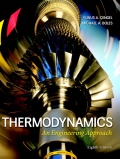
Concept explainers
The change in enthalpy
The change in entropy
The change in enthalpy
The change in entropy
Answer to Problem 71P
The change in enthalpy
The change in entropy
The change in enthalpy
The change in entropy
Explanation of Solution
Write the mean change in enthalpy
Here, enthalpy of water vapor at temperature of 647.1 K is
Write the change in enthalpy
Here, molar mass of water vapor is
Write the mean change in entropy
Here, gas constant is R, initial pressure is
Write the change in entropy
Write the reduced temperature
Here, critical temperature is
Write the reduced pressure
Here, critical pressure is
Write the reduced temperature
Here, critical temperature is
Write the reduced pressure
Here, critical pressure is
Write the change in enthalpy
Here, change in enthalpy of water vapor is
Write the change in enthalpy
Here, change in entropy of water vapor is
Conclusion:
Convert the unit of initial temperature
Convert the unit of initial temperature
Refer table A-23, “Ideal gas properties of water vapor”, obtain the enthalpy of water vapor at temperature of
Substitute
Refer table A-1, “Molar mass properties table”, obtain the molar mass
Refer the table A-20,”Water vapor properties of water vapor table”, select the entropy of water vapor at temperature of
Substitute
Substitute 873 K for
Substitute
Refer the table A-15, “Nelson-Obert generalized compressibility chart”, select the initial state of compressibility factor
Substitute 673 K for
Substitute
Refer the table A-15, “Nelson-Obert generalized compressibility chart”, select the initial state of compressibility factor
From the gas constant properties table A-1, select the gas constant of water vapor as
Substitute
Substitute
Thus, the change in enthalpy
Substitute
Substitute
Thus, the change in entropy
Refer table A-6, “Superheated water table”, select the inlet enthalpy and exit enthalpy at pressure of
Thus, the change in enthalpy
Refer table A-6, “Superheated water table”, select the inlet entropy and exit entropy at pressure of
Thus, the change in entropy
Want to see more full solutions like this?
Chapter 12 Solutions
EBK THERMODYNAMICS: AN ENGINEERING APPR
- Uppgift 2 (9p) I77777 20 kN 10 kN/m 4 [m] 2 2 Bestäm tvärkrafts- och momentdiagram för balken i figuren ovan. Extrempunkter ska anges med både läge och värde i diagrammen.arrow_forward**Problem 8-45.** The man has a mass of 60 kg and the crate has a mass of 100 kg. If the coefficient of static friction between his shoes and the ground is \( \mu_s = 0.4 \) and between the crate and the ground is \( \mu_c = 0.3 \), determine if the man is able to move the crate using the rope-and-pulley system shown. **Diagram Explanation:** The diagram illustrates a scenario where a man is attempting to pull a crate using a rope-and-pulley system. The setup is as follows: - **Crate (C):** Positioned on the ground with a rope attached. - **Rope:** Connects the crate to a pulley system and extends to the man. - **Pulley on Tree:** The rope runs over a pulley mounted on a tree which redirects the rope. - **Angles:** - The rope between the crate and tree forms a \(30^\circ\) angle with the horizontal. - The rope between the tree and the man makes a \(45^\circ\) angle with the horizontal. - **Man (A):** Pulling on the rope with the intention of moving the crate. This arrangement tests the…arrow_forwardplease solve this problems follow what the question are asking to do please show me step by steparrow_forward
- please help me to solve this problem and determine the stress for each point i like to be explained step by step with the correct answerarrow_forwardplease solve this problem for me the best way that you can explained to solve please show me the step how to solvearrow_forwardplese solbe this problem and give the correct answer solve step by step find the forces and line actionarrow_forward
- please help me to solve this problems first write the line of action and them find the forces {fx=0: fy=0: mz=0: and them draw the shear and bending moment diagram. please explain step by steparrow_forwardplease solve this problem step by step like human and give correct answer step by steparrow_forwardPROBLEM 11: Determine the force, P, that must be exerted on the handles of the bolt cutter. (A) 7.5 N (B) 30.0 N (C) 52.5 N (D) 300 N (E) 325 N .B X 3 cm E 40 cm cm F = 1000 N 10 cm 3 cm boltarrow_forward
 Elements Of ElectromagneticsMechanical EngineeringISBN:9780190698614Author:Sadiku, Matthew N. O.Publisher:Oxford University Press
Elements Of ElectromagneticsMechanical EngineeringISBN:9780190698614Author:Sadiku, Matthew N. O.Publisher:Oxford University Press Mechanics of Materials (10th Edition)Mechanical EngineeringISBN:9780134319650Author:Russell C. HibbelerPublisher:PEARSON
Mechanics of Materials (10th Edition)Mechanical EngineeringISBN:9780134319650Author:Russell C. HibbelerPublisher:PEARSON Thermodynamics: An Engineering ApproachMechanical EngineeringISBN:9781259822674Author:Yunus A. Cengel Dr., Michael A. BolesPublisher:McGraw-Hill Education
Thermodynamics: An Engineering ApproachMechanical EngineeringISBN:9781259822674Author:Yunus A. Cengel Dr., Michael A. BolesPublisher:McGraw-Hill Education Control Systems EngineeringMechanical EngineeringISBN:9781118170519Author:Norman S. NisePublisher:WILEY
Control Systems EngineeringMechanical EngineeringISBN:9781118170519Author:Norman S. NisePublisher:WILEY Mechanics of Materials (MindTap Course List)Mechanical EngineeringISBN:9781337093347Author:Barry J. Goodno, James M. GerePublisher:Cengage Learning
Mechanics of Materials (MindTap Course List)Mechanical EngineeringISBN:9781337093347Author:Barry J. Goodno, James M. GerePublisher:Cengage Learning Engineering Mechanics: StaticsMechanical EngineeringISBN:9781118807330Author:James L. Meriam, L. G. Kraige, J. N. BoltonPublisher:WILEY
Engineering Mechanics: StaticsMechanical EngineeringISBN:9781118807330Author:James L. Meriam, L. G. Kraige, J. N. BoltonPublisher:WILEY





